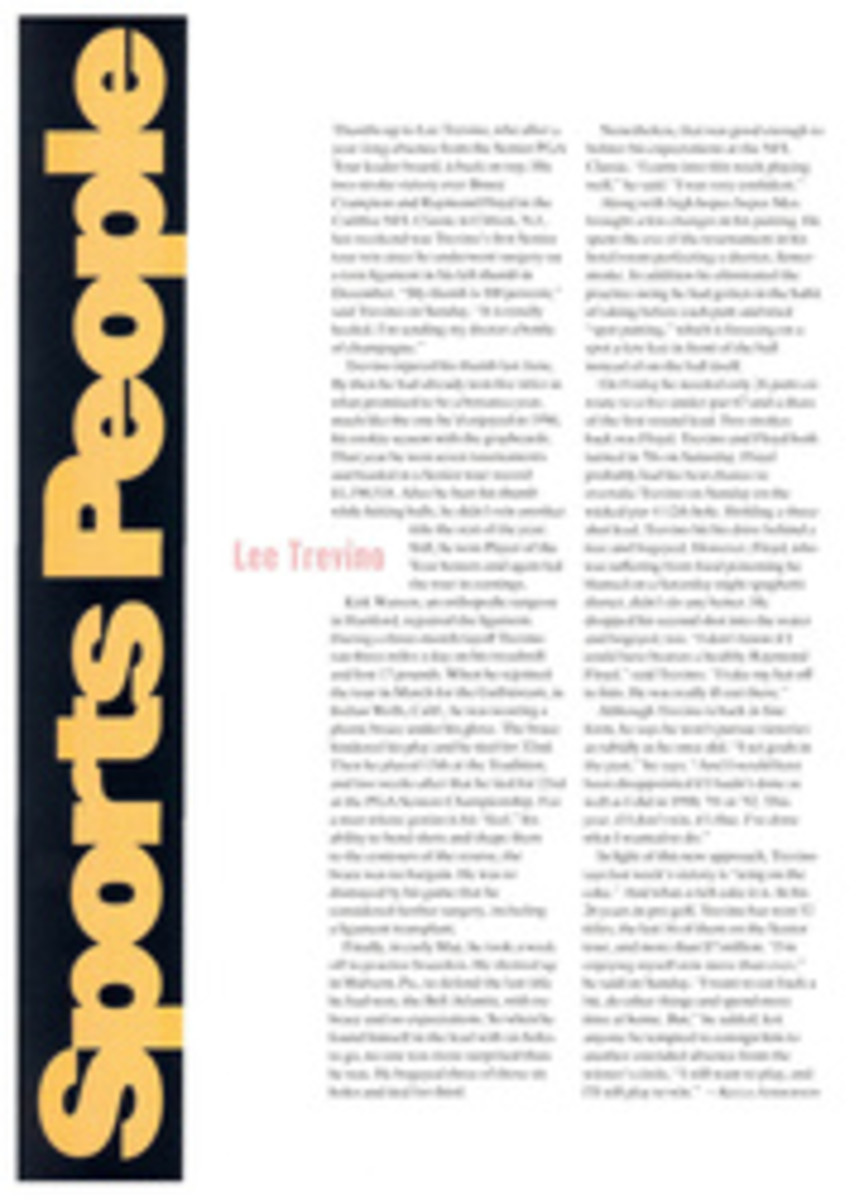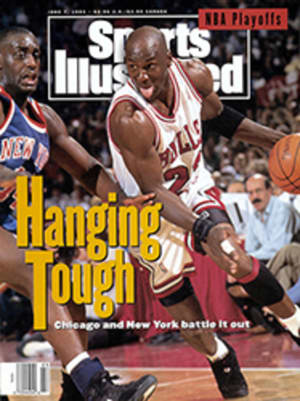
Mettle on the Pedal
The front straightaway at the Indianapolis Motor Speedway can be a terrifyingly lonely place, even when the grandstands are full and the people are rising on both sides in great waves. With six laps to go in Sunday's Indianapolis 500, just before the green flag had fallen on the final restart of the race, just such a sea of humanity loomed above the asphalt as the leader, Emerson Fittipaldi, pulled the cars of Arie Luyendyk and Nigel Mansell close behind him like beads on a glittering necklace.
"A month ago I was here all by myself testing the car, and driving down the straightaway I got the goose feeling," Fittipaldi said later. "It is so awesome, a magical place. When I was seven or eight years old in Brazil, I used to watch documentary movies about Indy, just wailing for this moment." But this was no movie. The voice of Chuck Sprague, Fittipaldi's team manager, crackled over the headset, but Fittipaldi silenced him. "The pressure was on," Fittipaldi said. "I knew Arie and Nigel were like a couple of foxes, that they were going to try to jump me, so I asked Chuck to leave me alone for a moment to concentrate on the restart. I knew I had to hit it just right."
As the cars swung through the short chute between the third and fourth turns, Fittipaldi slowed his Penske Chevy, forcing the others to back off their throttles too. "Emmo did a fantastic job of coining to a complete standstill," Luyendyk said later. "I had to drop into second gear to stay behind him, and when I did, he took off." When Luyendyk tried to accelerate after Fittipaldi, his car nearly turned sideways. From there Fittipaldi ran off with his second Indy 500 championship.
When Emerson and his wife, Teresa, had spoken to his mother, Juze—who used to race saloon cars in Brazil during the mid-1950s—in Sao Paolo the morning of the race, she was so nervous that she begged Teresa to link pairs of the golden sea horse earrings she wears for luck and hang them on each ear. Teresa's ears had been similarly adorned when Emerson won Indy for the first time, in 1989, and she had given a pair to Chris Mears, the wife of Emerson's teammate Rick Mears, in '91, the year Mears won his fourth Indy. Shelley Unser was wearing a pair when her husband, Al Jr., won the race last May, so this time Juze wanted to make sure the luck was with her son.
Yet Fittipaldi's luck appeared to turn sour midway through the race, when, in third place, just behind Mario Andretti, he rolled into the pits under a green flag, only to have the yellow come out two laps later. Fittipaldi, having dropped back to 10th during his pit stop, watched a parade of 23 cars come in for fuel and tires before the green flag waved again. "I was challenging Mario until that point," Fittipaldi said, "but it was very tough to move through traffic. I had to fight my way back slowly from there."
Like a great orange salmon battling its way upstream, Fittipaldi struggled along, breaching every time he could find some clean air. "Every time you got behind eight or nine cars, there was no air," said Mansell, the Formula One champion who finished third in his rookie outing at Indy, behind Luyendyk and ahead of Raul Boesel in the closest one-through-eight finish in 500 history. "The fumes were so bad my eyes were watering."
The drivers had complained all month about dirty air, the term they use for the invisible turbulence the cars leave in their wake. The difficulty was compounded this year by the new configuration of the track, which eliminated a 12-foot apron below the inside white line in the corners and replaced it with grass. "Last year you could sail-ass down the straightaway and then dive down in the turns," said owner Dick Simon, who had five cars in the race, the most of any owner in 60 years. "But if you try that this year, you'd better bring a lawn mower with you."
The new track design, as well as mandatory changes in the cars' aerodynamics, lowered speeds—Luyendyk won the pole at an average speed of 223.967 mph, well below Roberto Guerrerro's 1992 time of 232.482 mph—and tightened the starling grid to within 6.737 mph from front to back. This made the skill of the drivers more important than ever, while also irritating the hell out of them. Said Luyendyk, "I might be fine going into Turn 1, fine in Turn 2, and then going into Turn 3 the car might not want to turn left."
"Everybody says the speeds have slowed down, but they haven't," Simon insisted. "We're just driving a real 2.5-mile track now. When drivers started going below the painted line, they were actually going 2.3 miles around. Most of these drivers think there are four turns, but there are really only two. The cars never stop turning in the short chutes between 1 and 2, and 3 and 4, which means the track is about five-eighths turn and three-eighths straightaway."
If there was a car that was half again as good as everybody else's three eighths of the time, it belonged to Andretti, who once again led more laps than anybody else (73) and once again left Indianapolis more obviously disappointed than anybody else. Andretti finished fifth and now has but a single victory in 28 starts at the Speedway. At 53, he had already won a race at Phoenix this year, and though he has frequently mentioned the ordeal of adjusting to the loss of his son Michael to the Formula One circuit, the younger Andretti's absence has turned up the old man's competitive fire. "To be honest, I got to the point where Michael was deflating the hell out of me," Mario said. "I could not beat him."
Michael was replaced on the Newman-Haas Indy Car team by Mansell, and in the weeks leading up to the race, Mario and his new teammate seemed to get along best when they stayed out of each other's way—something they seemed disinclined to do on Sunday. Mansell, who had complained privately to his crew that Andretti had barely spoken to him all month and had stolen some of his racing setups during practice to boot, began stalking Andretti on Lap 46, and it was eight laps and several wheel-to-wheel blocking maneuvers by Andretti before Mansell could get past him.
Andretti was disconsolate after the race, and it was difficult to determine whether his anguish was the result of his car's having handled poorly on a fresh set of tires in the final 50 miles of the race or because Mansell had drained most of the glory out of Andretti's afternoon by bettering him on racing's biggest day. If the wheels fall off this fragile partnership, it will probably be because the two former F/1 champions (Andretti won the title in 1978) generate almost as much ego as horsepower. "I wouldn't trade my career for his," Andretti had said dismissively earlier in the month. "I have nothing to apologize for. I've accomplished a hell of a lot more than he has, so what am I worried about?"
If this was not the fastest starting field in Indy's history, it was easily the most fertile in memory. Paul Tracy, whose crash on Lap 96 allowed Fittipaldi to scramble all the way around the track under a caution flag and move back into the top 10 at the halfway point, spent three days during race week in Toronto, where his wife, Tara, gave birth to their first child during carburetion testing on Thursday. With characteristic Team Penske efficiency, labor commenced Wednesday night, the checkered flag came down on the birth of seven-pound, eight-ounce Alysha with five minutes left in carburetion testing, and Dad was back at Indy by Friday.
"Paul is not doing the timing right," said his teammate Fittipaldi, who shook down Tracy's car for him. "You should count nine months before Indy and take it easy." Luyendyk's wife, Meike, expecting twins in July, began experiencing false labor contractions on Thursday, demonstrating the family's competitive spirit. And Eddie Cheever raced while his wife, Rita, remained in her native Italy ready to deliver at any moment. "What it proves," said Cheever, "is that drivers have far too much free time."
Rita Cheever's husband was not at her side only because he had barely qualified for the race a week earlier—by bumping defending Indy Car champion Bobby Rahal from the field. Rahal and co-owner Carl Hogan had spent the early part of the season nursing along their balky chassis, and it finally cost them when Rahal failed to make the field for the first time in his 12 years at Indy. Rahal might have seen it coming if earlier in the month someone hadn't jostled the Borg-Warner championship trophy and knocked the glasses off Rahal's sculpted likeness thereon. By last weekend, life-sized cardboard cutouts of Rahal bearing such unkind messages as NEED 4 TICKETS and WILL WORK FOR FOOD stood in front of the RV camps outside the track.
Fittipaldi had reached an equally low ebb in his career 12 years ago, when, nearly broke, he abandoned Formula One and went to Brazil to tend his orange groves for two years. He joined the Indy Car circuit in 1984, a move he likens to "being born again." After finishing third at Indy in '90, he was forced out late in the race with mechanical problems in '91. That afternoon he sat in the garage and wept as Mears took the checkered flag. "It was a race I felt like I had won," Fittipaldi said on Sunday. "That Indianapolis for me is the most emotional race in my career."
Fittipaldi—who eschewed the traditional swallow of milk in the winner's circle to swig orange juice instead—was among the vanguard in the growing wave of international drivers at Indy that crested last week with tidal force, when the top four finishers were foreign. "When they talk about the foreign element, it's like they're talking about some——plague," said the Dutch-born Luyendyk, who, like Fittipaldi, lives most of the year in the U.S. "We're one of you."
And, in Fittipaldi's case, like no one else.
PHOTO
TOM LYNN
Emmo made it to the winner's circle—for a tradition-shattering gulp of orange juice—with an assist from Teresa's lucky jewelry.
TWO PHOTOS
JOHN BIEVER
[See caption above.]
PHOTO
TOM SNYDER/AFP
Veteran Rahal missed the cut, while rookie Mansell (5) skirted one of the few wrecks.
PHOTO
JERRY WARD
[See caption above.]
PHOTO
AMY SANCETTA/AP
On Lap 185, Fittipaldi passed Luyendyk (rear, left) and Mansell to lead for the first time.

